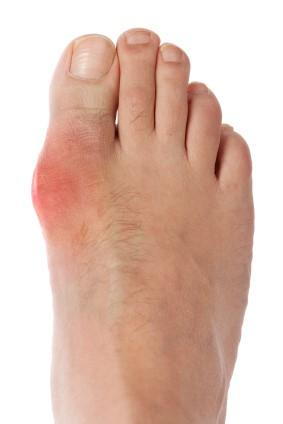 The medical condition that is referred to as gout is considered to be a form of arthritis. Many patients experience severe pain and discomfort during a gout attack, and it typically occurs in the big toe. The general symptoms of gout may include redness, tenderness, or swelling in the joints of the big toe and surrounding areas. Research has shown there are two types of gout. These are known as chronic and acute gout. During an acute attack, most symptoms will disappear once the attack is over, and a limited amount of joints are affected. Chronic gout is having multiple gout attacks throughout the year, and symptoms may be felt for the majority of the time. Additionally, permanent damage may occur which may include stiff joints or damage to the toe. If you are going through a gout attack, it is advised to consult with a podiatrist who can guide you toward beginning proper treatment.
The medical condition that is referred to as gout is considered to be a form of arthritis. Many patients experience severe pain and discomfort during a gout attack, and it typically occurs in the big toe. The general symptoms of gout may include redness, tenderness, or swelling in the joints of the big toe and surrounding areas. Research has shown there are two types of gout. These are known as chronic and acute gout. During an acute attack, most symptoms will disappear once the attack is over, and a limited amount of joints are affected. Chronic gout is having multiple gout attacks throughout the year, and symptoms may be felt for the majority of the time. Additionally, permanent damage may occur which may include stiff joints or damage to the toe. If you are going through a gout attack, it is advised to consult with a podiatrist who can guide you toward beginning proper treatment.
Gout is a painful condition that can be treated. If you are seeking treatment, contact Dr. LeKeisha George from Forest Hills Podiatric Medical Care. Dr. George will treat your foot and ankle needs.
What is Gout?
Gout is a form of arthritis that is characterized by sudden, severe attacks of pain, redness, and tenderness in the joints. The condition usually affects the joint at the base of the big toe. A gout attack can occur at any random time, such as the middle of the night while you are asleep.
Symptoms
- Intense Joint Pain - Usually around the large joint of your big toe, and it most severe within the first four to twelve hours
- Lingering Discomfort - Joint discomfort may last from a few days to a few weeks
- Inflammation and Redness -Affected joints may become swollen, tender, warm and red
- Limited Range of Motion - May experience a decrease in joint mobility
Risk Factors
- Genetics - If family members have gout, you’re more likely to have it
- Medications - Diuretic medications can raise uric acid levels
- Gender/Age - Gout is more common in men until the age of 60. It is believed that estrogen protects women until that point
- Diet - Eating red meat and shellfish increases your risk
- Alcohol - Having more than two alcoholic drinks per day increases your risk
- Obesity - Obese people are at a higher risk for gout
Prior to visiting your podiatrist to receive treatment for gout, there are a few things you should do beforehand. If you have gout you should write down your symptoms--including when they started and how often you experience them, important medical information you may have, and any questions you may have. Writing down these three things will help your podiatrist in assessing your specific situation so that he or she may provide the best route of treatment for you.
If you have any questions, please feel free to contact our offices located in Forest Hills, NY. We offer the newest diagnostic and treatment technologies for all your foot care needs.
Read more about Gout